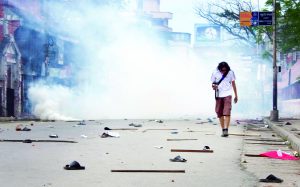
New global study documents best practices on the safety of journalists
‘Defending Journalism’, a new global study by International Media Support (IMS) analyses the efforts to safeguard journalists in seven countries where environments of conflict and instability challenge the ability of journalists to produce good, in-depth journalism
Approximately 640 journalists have lost their lives in the last decade of which over 90 per cent took place in countries with conflict or authoritarian regimes. IMS’ study ‘Defending Journalism’ aims to provide a mapping and greater understanding of what works – and what does not work when it comes to addressing the safety of journalists.
The seven countries in focus – the Philippines, Indonesia, Pakistan, Iraq, Nepal, Colombia and Afghanistan – were selected for analysis because they showcase a varied range of responses to improving the safety of journalists.
“Our study shows that the most effective responses to the safety of journalists are those born and led by a broad coalition of stakeholders that includes media, civil society, authorities where possible and international organisations,” Jesper Højberg, Executive Director of International Media Support (IMS) explains.
Afghanistan and Colombia have succeeded in establishing broad, locally anchored coalitions of government authorities, media and civil society organisations around so-called national “safety mechanisms”, a series of interlinked activities that together address the safety of journalists.
These mechanisms aim to provide journalists in distress with a “package” of assistance depending on their immediate needs such as emergency support including relocation, safe houses, legal advice, safety training workshops, conflict sensitive journalism training and advocacy campaigns against press freedom violations and for improved legislation.
Innovation is needed

However, in countries where the police and government are amongst the perpetrators, media and press freedom organisations must think innovatively. In Bagdad, Iraq, media and security forces have signed an agreement “regulating” their relationship following dialogue meetings. In the Philippines, press freedom advocates have teamed up with Catholic Church to shelter journalists under threat. In Pakistan, six press clubs across the country work together to provide safety hubs for journalists in need of help.
One of the weaknesses of these country-wide mechanisms, as also pointed out in the study, is the fact that the mechanisms are largely dependent on foreign funding to function. Also, a lack of coordination and agreed joint priorities amongst international media development organisations and amongst local media development actors in some of the countries surveyed, has in some instances weakened the overall impact of the efforts made to improve safety.
“All media stakeholders from government to media, police authorities and civil society must take responsibility and work together to ensure the media’s ability to report freely, safely and accurately without fear of retribution,” Jesper Højberg emphasises.
“This is why the UN Plan of Action on the Safety of Journalists and the Issue of Impunity adopted by UN member states in 2012 is an important instrument to connect local efforts on the safety of journalists to international ongoing discussions on the issue. The ability of journalists to safely carry out their role as society’s watchdog is an issue that concerns us all.”
The global study will be launched in Denmark at our Closing Spaces debate seminar on 16 November, which IMS is hosting along with the Danish National Commission for UNESCO.
The publication ‘Defending journalism: how national mechanisms can protect journalists and address the issue of impunity – a comparative analysis of practices in seven countries’ is part of a larger project on the safety of journalists financed by the Danish Ministry of Foreign Affairs which includes a peer-to-peer sharing of best practices on safety across borders co-implemented by the International Federation of Journalisms (IFJ). The mechanisms surveyed in the publication can also be found on The Journalists’ Protection wiki.
For more information contact Helle Wahlberg, International Media Support on hwa@mediasupport.org.




